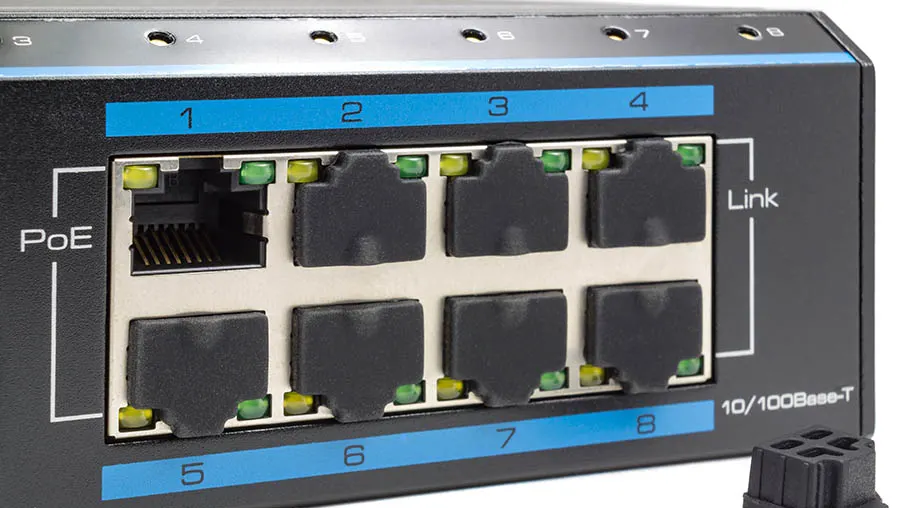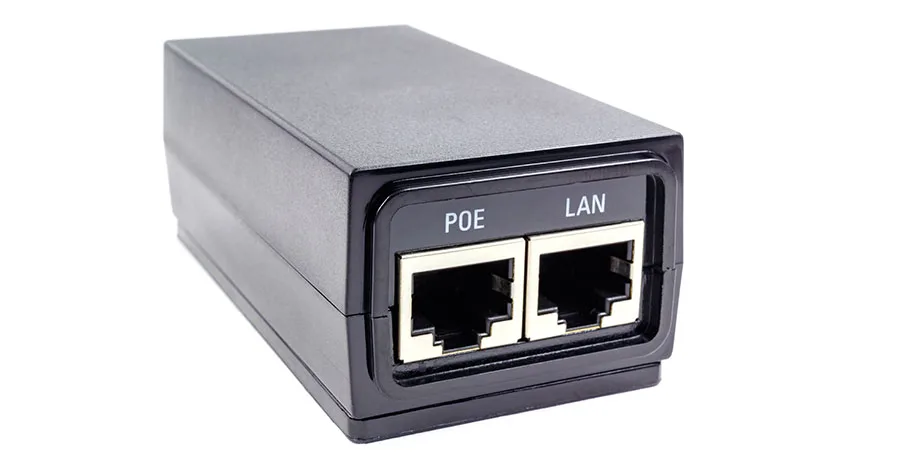When setting up a system based on PoE enabled devices, you might benefit from understanding what PoE passthrough ports are and how to use them. Using them in your system can save you time and make for a cleaner installation.
PoE passthrough ports are RJ45 connections on a PoE-enabled switch that provide power to the switch and other connected devices. Instead of using a regular power adapter, you can connect a PoE cable to one of these ports to enable power across the other connections.
PoE passthrough may sound complicated, but in reality, they offer your system convenience and makes it easier to install extra PoE devices. All you need to do for most systems is plug in the right cables into the correct ports, and you are ready to go. Read on to learn more about this technology and how you can use it to your advantage.
What’s PoE, and What Are PoE Passthrough Ports?

PoE simply stands for power over ethernet. It’s a technology developed to help power low wattage to high wattage devices across a network with one cable. This technology is based on the paired twisted wires of an ethernet cable.
Inside a Cat5/Cat6 ethernet cable, you will find four sets of paired wires. Two of these sets usually carry the data and information while the other two can carry the voltage needed to power specific devices. These two paired wired sets create a loop that can carry power.
PoE comes in several power ratings. These allow for more power hungry devices to be installed on a system. Most PoE systems you will see today are usually PoE standard or the more powerful PoE+. More advanced PoE ratings exist, but for most consumer applications are not necessary. There are lots of PoE devices. Some require more wattage than others, including:
- IP Cameras
- VOIP Phones
- Wireless Access Points
- Network Switches (Like our PoE passthrough)
- IP Speakers
- Some specialized TVs and Monitors
These are just a few of the devices you can use with PoE capabilities. Some require more power than others and may need to be used with PoE plus, which supports these higher power-consuming devices. Always check the manufacturer’s information before setting up multiple devices.
PoE is an excellent addition to any system and can save you from running multiple wires for both data and power. But another feature that can create convenience in your system is PoE passthrough ports. PoE passthrough ports allow for a device, like a network switch (on Amazon), to be powered by PoE itself. This means that you can have multiple devices hooked up to a PoE switch and have the passthrough connections power them all. This eliminates the need for external power sources and extra cables.
These switches work by allowing operation by either PD (Powered Device) or PSE (Power Sourcing Equipment). This is what allows for power to be moved through the system. PoE passthrough ports are a great addition to any system but can be especially helpful when working with limited access to power outlets.
How are PoE Switches Used?

As we briefly mentioned in our article on laptops and PoE, because PoE cables are used to transfer both data and power over a single cable, they are used abundantly in network setups that use multiple devices. PoE switches make your setup even easier by allowing various devices to be connected to the network and the power source without needing direct connections to your central unit (more on switches and injectors in our guide). These switches can act as a hub for connections.
They work great if you are in a situation where you need to connect multiple devices and don’t want to run tons of wires. An excellent example of when a PoE-enabled switch is useful is an office setting. In this situation, you could run individual wires both to the network and the power source for each device you want to connect, but if you are connecting, say, 16 VOIP enabled phones, this can be tedious.
Not only will you need to connect each line up to your router, but you will also need to find power for each device. Imagine how, in this situation, not having a switch available to handle all the connections can make for a more involved installation. A PoE switch will allow all of the phones and other PoE devices to be connected to power and the network through the switch.
The switch will then have access to the network through a router or other access point. PoE switches aren’t just great for office spaces; they also are helpful in places like classrooms, hotel rooms, computer labs, or any other relatively small space.
PoE Injectors

Sometimes a simple network cable has been run that doesn’t have PoE. But there is a way to add power to a smaller stretch of the networked system: through a PoE injector (on Amazon). This device will do the same task as a switch but only support one line.
If you are using more than two of these injectors, you may want to invest in a PoE switch using our guide as a frame of reference. Using too many PoE injectors can make for a cumbersome and untidy setup. Most PoE enabled switches also have available non-PoE ports. This means that you can use the switch with things like network access without worrying that the power transferred through the cable will damage your non-PoE devices.
Other Information on PoE Switches and PoE Passthrough Ports
When considering using PoE in your system, always ensure that the connected devices are compatible. There are not only power limitations you need to be aware of, but there can also be compatibility problems with tools like IP Cameras. First, you should make sure you know what kind of power your devices are going to need.
Some devices, like IP cameras of VOIP phones, don’t need a whole lot of power. These devices can manage with around 15 watts of power. PoE plus can support devices that need up to about 30 watts. This is for things like TV monitors and alarm systems. There is even a PoE++ system that can power devices that are more powerful, but you probably won’t come across a need for this in a normal consumer setup.
Every device you connect to your PoE switch will have a power rating that you should understand, in fact, there are a few other things you should know about that we’ve discussed before. While there are products out there that can manage your power across multiple devices, looking into what wattage your devices need can help keep them from being damaged, which is great if you don’t want to spend any extra money due to mistakes.
